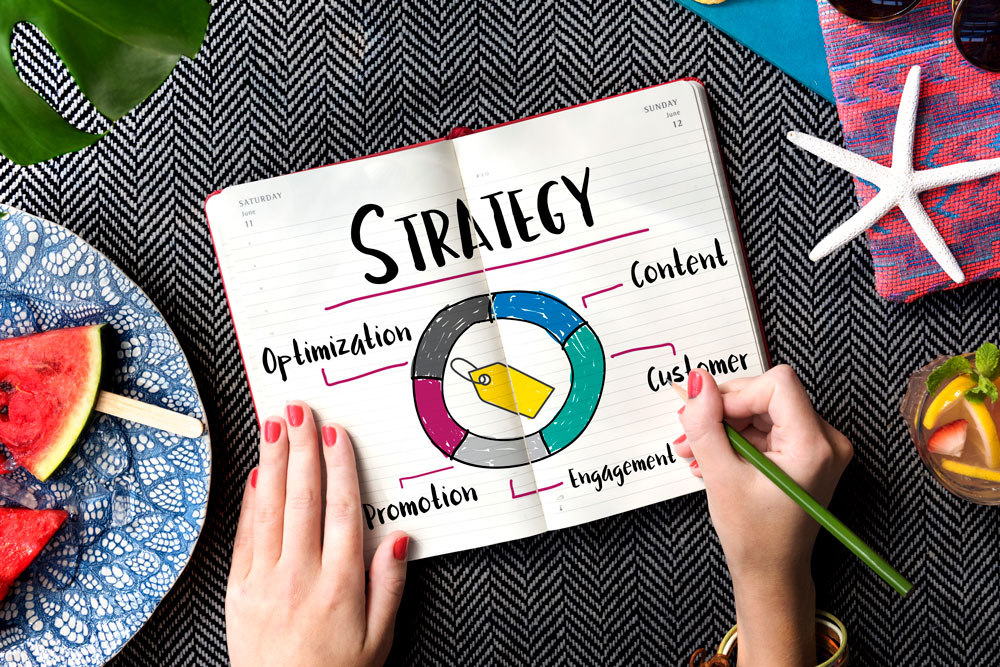Without a clear plan, advertising your product on social media is naive at the very least. Promotional materials and ads will no longer surprise local users, so they are in no hurry to buy or order things. It makes sense to fight for the attention of a potential customer. And not spontaneously, but with a developed strategy.
In this article, you will learn what an SMM strategy is for and what elements it consists of. You will also learn why it needs to be developed. Details are important.
Why do you need an SMM strategy
An effective SMM strategy is important because it allows you to set specific, measurable goals, predict future costs, and develop forecasts for marketing efforts. Before launching social media campaigns, you can estimate your budget and decide whether this is the right time to invest in social media or if you should look at other marketing tools. An SMM strategy offers the following benefits:
- Saving money
Even launching test ad campaigns requires expenses. Without properly configured parameters, there is a risk of losing money without getting the desired results.
- Saving time
Without a clear strategy, much more time will have to be spent on experimenting and finding optimal solutions. Without a predefined strategy, it is difficult to predict the exact costs and choose effective tools.
- Team coordination
When a team has a clear SMM strategy, it works smoothly and without conflicts. Establishing a common action plan and clear goals helps to increase the confidence and productivity of each team member. Studies show that people work much more efficiently when they act according to a pre-designed plan and have clear goals.
With a well-thought-out SMM strategy that includes an in-depth analysis of the product, competitive environment, and target audience, you can clearly define the direction for your marketing campaign. This will ensure that you have an effective action plan in place before you start advertising activities. Even if the strategy doesn’t bring the expected results at first, a systematic approach is usually more effective than random actions or dependence on intuition.

Preparing to create an SMM strategy
Let’s start with research. Study your product, look at competitors, and learn about the expectations of your target audience. This is a complex procedure, without which an effective network marketing strategy for a company will not be effective.
Analysis of the Target Audience
The key to a successful strategy is a deep understanding of your target audience. It is important to determine who will interact with your content. It’s not enough to create a superficial portrait, such as “a man in his 20s or 30s with an average income”. You need to understand where your potential customers live, what they are interested in, what their fears and objections are.
Competitor Research
The first step is to identify competitors who offer similar products or services. It’s important to find out what marketing tools they use, identify their strengths and weaknesses. You can even act as a potential customer of a competitor to assess the quality of their service.
If there are no direct competitors, pay attention to companies that can attract the same audience in other ways. For example, your pizzeria can compete not only with other pizzerias, but also with sushi bars or fast food outlets. Remember that even if the products are different, there is always competition.
Product Analysis
A key aspect of success is a deep understanding of your offer. It is important to determine why customers should choose your product over a competitor’s. This understanding should be objective, not just based on your own conviction of its benefits.
To evaluate the product in detail, follow these recommendations:
- Communicate with customers and the team: It is important to communicate with customers, support, and managers to understand how customers perceive the product — what they like and what causes dissatisfaction.
- Personal use of the product: If you work in the food industry, try your own dishes. If it’s a service, try it out for yourself. Evaluate the product from the customer’s point of view, trying to be as objective as possible.
- Familiarization with the production process: Consider the production process from the perspective of a marketer, not a manufacturer. Examine who does what and how, what resources are used, and how this can affect the perception of the product.
Your strength lies in a thorough knowledge of the product, which is the key to effective communication with the target audience.
![]()
Choosing social networks and creating a community concept
Choosing the right social network to promote your product is an important decision. Whether it will be Facebook, Instagram, or another platform depends on the location and activity of your target audience. You need to analyze in depth where your audience spends most of their time.
It’s also important to consider the specifics of the content that is suitable for each social network. For example, Instagram focuses on visual content such as photos and videos, while Facebook is better suited for informational and textual content with a wider range of post formats. Your choice of social network will affect the timeframe and initial budget for SMM promotion. Over time, the strategy can be changed and new channels added if it is economically feasible.
The concept of a community is an expression of your company’s core values and principles, which forms the basis of a social media promotion strategy. The same product can be presented in different ways, for example, an elite residential complex can be positioned as an ideal place for family life or as a space for self-expression and freedom. Depending on the approach you choose, you will shape the image, meanings, benefits, and unique features of the product that will be broadcast in your community.
Goals and objectives of the SMM strategy
The foundation of any long-term project is clearly defined goals and objectives. Ideally, these goals are formulated in accordance with the SMART model, which means that they should be specific, measurable, achievable, relevant, and time-bound. This is critical because without the ability to measure goals, it is impossible to track progress.
The main performance indicator in SMM is KPI (key performance indicators). These can include increasing the number of subscribers, increasing the reach and activity in an account or community, and increasing the amount of traffic to a website.
Other important metrics are the number of content views, growth in the number of subscribers, frequency of sharing messages by users, conversion rate of visitors to customers, cost per customer, etc.
Analysis of the Current State
At the initial stage, we collected important information about the target audience, competitors, and delved into the details of our product. Now it’s time to use this data to analyze the current market situation. We need to think carefully about what we can offer our target audience and how to redirect their attention from competitors’ products to ours. It is also worth considering past experience, both positive cases and failures, analyzing the reasons and avoiding similar mistakes in the future.
Defining Positioning
When working on social media, it is necessary to present information about your product in a clear and high-quality manner. Before launching SMM promotion, it is important to decide on the main topic, style, and design of your account or community. This significantly affects the perception of your posts by the audience. Effective positioning aims to distinguish your company from competitors by creating an image of a reliable and attractive brand in the eyes of potential customers.

Developing an SMM Strategy
The first impression of a community or social media account is formed through its design. Clarity and precision of information about the company’s activities and products are key. If the design is not well thought out or the publications do not have a single style, there is a risk that the visitor will quickly leave the page.
Visual Style and Brand Recognition
The look your brand chooses on social media is a kind of business card for your business. When developing a design, it’s important to consider the emotional reactions of your audience and strive for harmonization with your brand. The design should match the characteristics of your target audience and the specifics of your business. For example, a colorful design that may be interesting for other industries may not be of serious interest to potential clients of a law firm.
Development of the Text Style
The style of text presentation is no less important than the visual component. Determining the “tone of voice” of your company is the process of choosing the appropriate way to communicate with the audience that reflects the brand’s characteristics. This style should be consistent across all publications and reflect your brand’s values and identity.
There are 4 main types of Tone of Voice:
Friendly Tone
- Style: Informal, warm and direct.
- Specialties: Texts are written in the format of friendly communication, using the address to “you”. Brands often share internal moments with the audience and introduce the team.
- Beware: It is important to maintain a balance and avoid being too familiar.
Provocative Tone
- Style: Evokes emotion, often bordering on challenge.
- Features: Used to grab attention through unexpected or explicit messages. Slogans and advertising campaigns can be on the edge of decency.
- Effect: Causes discussion, controversy, memorable, but can be risky.
Expert Tone
- Style: Professional, informative, with an emphasis on knowledge.
- Features: Content is focused on providing useful information, advice, and expert knowledge. Publications usually contain life hacks, instructions, detailed analyzes.
- Tone: Formal but friendly, aimed at increasing trust through demonstrating knowledge and authority in the industry.
Entertainment Tone
- Style: Light, fun, entertainment-oriented.
- Features: Includes elements of humor, games, polls, contests. Texts may contain jokes and other entertaining elements.
- Important: Maintain a balance and not cross the line, staying within the framework of a reasonable and appropriate brand.

Development of the Content Plan
Detailing of Publications
- It is important to accurately plan future publications, indicating the type of each post (advertising, informational, etc.).
- Planning does not have to be a year in advance, but the more long-term the plan, the better.
Development of Headings
- Determine the main headings you will maintain.
- Consider important events for the company, national holidays, thematic events.
Activity Plan
- As a complement to the content plan, develop an activity plan, including contests, games, polls, giveaways.
Miscalculation of Advertising and Targeting
- Based on the content plan, you can calculate the future costs of advertising campaigns.
- An analysis of the target audience, cost per click, reach, and other key parameters will help you predict advertising costs.
Comprehensive planning and detailed miscalculation allow you to optimize costs and increase the effectiveness of SMM campaigns.
Post Strategy Development: Publication, Analysis, Automation, and Correction
So, the strategy has been developed, now it’s time to act according to the plan. We publish content and closely monitor its effectiveness. The main task is to make sure that the strategy is working effectively by analyzing the audience’s reach and interaction with the posts. A high level of views and interactions indicates success.
Please remember that there are two types of control: operational (procedural) and strategic (target). It can be difficult to evaluate long-term goals, so it is recommended to analyze the results for certain periods of time and compare them with the defined KPIs.
The development and implementation of an SMM strategy requires significant time and financial resources. Be prepared for hard and meaningful work. Alternatively, you can turn to SMM professionals who will prepare and implement the strategy for you.


